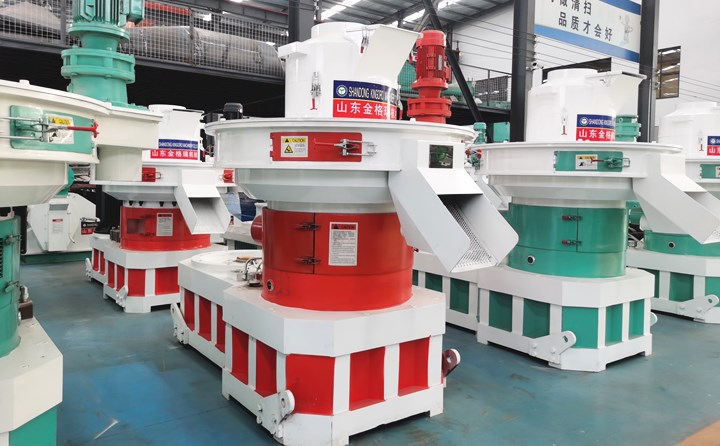The main material forms that constitute biomass particle molding are particles of different particle sizes, and the filling characteristics, flow characteristics and compression characteristics of the particles during the compression process have a great influence on the compression molding of biomass.
Biomass pellet compression molding is divided into two stages.
In the first stage, in the early stage of compression, the lower pressure is transferred to the biomass raw material, so that the original loosely packed raw material arrangement structure begins to change, and the internal void ratio of the biomass decreases.
In the second stage, when the pressure gradually increases, the pressure roller of the biomass pellet machine breaks the large-grained raw materials under the action of pressure, turning into finer particles, and deformation or plastic flow occurs, the particles begin to fill the voids, and the particles are more compact. They mesh with each other when they are in contact with the ground, and a part of the residual stress is stored inside the formed particles, which makes the bonding between the particles stronger.
The finer the raw materials that make up the shaped particles, the higher the filling degree between the particles and the tighter the contact; when the particle size of the particles is small to a certain extent (hundreds to several microns), the bonding force inside the shaped particles and the primary and secondary even will also change. Changes occur, and the molecular attraction, electrostatic attraction, and liquid phase adhesion (capillary force) between particles begin to rise to dominance.
Studies have shown that the impermeability and hygroscopicity of the molded particles are closely related to the particle size of the particles. The particles with small particle size have a large specific surface area, and the molded particles are easy to absorb moisture and regain moisture. Small, the voids between particles are easy to fill, and the compressibility becomes larger, so that the residual internal stress inside the shaped particles becomes smaller, thereby weakening the hydrophilicity of the shaped particles and improving the impermeability of water.
In the study of particle deformation and binding form during compression molding of plant materials, the particle mechanical engineer carried out microscope observation and particle two-dimensional average diameter measurement of the particles inside the molding block, and established a particle microscopic binding model. In the direction of the maximum principal stress, the particles extend to the surrounding, and the particles are combined in the form of mutual meshing; in the direction along the maximum principal stress, the particles become thinner and become flakes, and the particle layers are combined in the form of mutual bonding.
According to this combination model, it can be explained that the softer the particles of the biomass raw material, the more easily the two-dimensional average diameter of the particles becomes larger, and the easier the biomass is to be compressed and molded. When the water content in the plant material is too low, the particles cannot be fully extended, and the surrounding particles are not tightly combined, so they cannot be formed; when the water content is too high, although the particles are fully extended in the direction perpendicular to the maximum principal stress, The particles can be meshed together, but since a lot of water in the raw material is extruded and distributed between the particle layers, the particle layers cannot be closely attached, so it cannot be formed.
According to the experience data, the specially-appointed engineer came to the conclusion that it is better to control the particle size of the raw material within one-third of the diameter of the die, and the content of fine powder should not be higher than 5%.
Post time: Jun-08-2022










